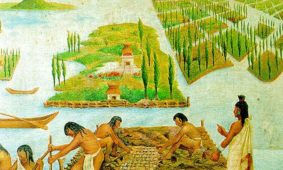Butterfly
Butterflies are beautiful, graceful creatures and there are over 20,000 different species located in many parts of the world. They also provide a very important service for the plant kingdom: pollination. While they perch on a flower to drink the nectar that sustains them, some of the pollen dust sticks on their wings and legs. As they
READ ARTICLESpiny Orb Weaver
The Spiny orb weaver is one of many species of beneficial spider that feasts on small garden pests. Their common name is appropriately labelled, the spider has six pointy projections located around its abdomen. Bright coloration of the abdomen such as yellow, red, white and black are associated with this interesting critter, and the rest of its body
READ ARTICLEDragonfly
Dragonflies are graceful, brightly colored predatory insects with four wings and a long body. Large ancestors of dragonflies, those with a three-foot wingspan, were on this planet longer than we can imagine. Fossil records show that dragonflies have been here since before dinosaurs appeared! They fly over open areas of water, fields, and wetlands with ease.
READ ARTICLEPraying Mantis
The common name praying mantis refers to the typical “prayer-like” posture the insect has, with folded forelimbs. In fact, mantids specialize in preying! The preying mantis is almost a perfect insect-hunting machine. This may be why mantids are one of the first species people think of when the term beneficial insect is mentioned.
READ ARTICLEAztec chinampas of Central America
An example of hydroponic principles that were being used successfully is that of the Aztecs of Central America. A nomadic tribe, they were driven onto the marshy shore of Lake Tenochtitlan, located in the great central valley of what is now Mexico. Roughly treated by their more powerful neighbors, denied any arable land, the Aztecs […]
READ ARTICLEHydroponics First Recorded Scientific Experiments
Some three centuries ago, john Woodward, an English scientist and a fellow of the Royal Society, undertook the first recorded scientific experiments on the subject of plant nutrition. He wanted to know whether plants drew nourishment from the soil or from water. Woodward discovered that adding small amounts of soil to the water in which […]
READ ARTICLELadybug
What is it about the tiny Lady Beetle that makes people like them? Is it their bright colors or domed shape? Or do we sense how much good they’ve done us through the centuries? Whatever the attraction, it’s gone on for a long time and is quite widespread.
Many European cultures had a high regard for this beetle family as early
READ ARTICLEGreen ‘Lynx’ Spider
The Green ‘Lynx’ Spider is found on all kinds of shrub-like plants throughout the southern United States, Mexico, Central America, Venezuela and the West Indies. You can find the Green ‘Lynx’ Spider in woods on tall grasses and in meadows of tall wildflowers, especially on the heads of wild buckwheat. The Green ‘Lynx’ Spider is a common resident in Texas
READ ARTICLEThe History of Hydroponics
Hydroponics basically means working water (“hydro” means “water” and “ponos” means “labor”). Many different civilizations have utilized hydroponic growing techniques throughout history. As noted in Hydroponic Food Production (Fifth Edition, Woodbridge Press, 1997, page 23) by Howard M. Resh: “The hanging gardens of Babylon, the floating gardens of the Aztecs of Mexico and those of […]
READ ARTICLE
















